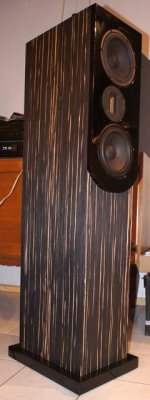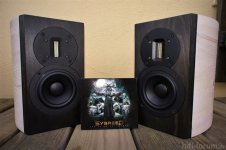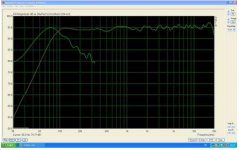just because someone has done tones of kits does not mean they are very interesting or very good, not in my book at least
Probably time for you to get a new book and catch up with what the rest of this community thinks.
Alright then, so what do you recommend then? It's fine to say that so and so is "lousy", but back it up with an example of what isn't.
Probably time for you to get a new book and catch up with what the rest of this community thinks.
So do you think the rest of the forum agree with you? I do not think so.
@Alexium:
It cannot be said that a 3-way loudspeaker is automatically better than a 2-way loudspeaker. Modern drivers are also able to deliver very good sound with only 2-way. Much more important than the drivers themselves, however, is the designer's ability. A really good designer can conjure up excellent loudspeakers even from cheap chassis. For example, take a look at the Sippo here:
Sippo – Donhighend Audio
Back then, the drivers cost € 8 / $ 9.50 - for both speakers!
Many would call this cheap junk, but the sound that comes out of it is unbelievable. At the Hifi-Music World 2009 there were a lot of different diy speakers present, in price ranges up to several thousand euros with Scanspeak, PHL, Eton, Seas Excell etc.
The secret star was the Sippo. It was so well received by the audience that the organizers asked the designer to leave the loudspeakers with them and present them in an online article.
Hifi-Selbstbau - Sippo, das Sparwunder
This shows very nicely that a lot of people pay far too much attention to the manufacturer's brands.
I've built Dennis Murphy's ER18MTM and Paul Carmody's Speedster myself.
Also heard some speakers from Troels. They were all really good, but if I had to choose between the ER18MTM and the Italian Stallion, I would clearly prefer the Italian stallion.
Attachments
Sippo is 16 db down @ 100 hz & 25 db down @ 50 hz. Fine if you listen only to guitar & voice. Nice midrange. There are other instruments. I play them, that produce a lot of 54 hz and occasionally 27. I can't practice enough to play all piano literature, and I don't have enough house for a pipe organ. Nor $40000 for one.
Is everybody running a splitter, a external sub filter, and a 2nd amp for the piano organ frequencies? My $300 speakers were reproducing 50-17 khz +- 3 db. Now they are stolen I can't buy any more, they are $650 each now delivered and made by serfs.
Is everybody running a splitter, a external sub filter, and a 2nd amp for the piano organ frequencies? My $300 speakers were reproducing 50-17 khz +- 3 db. Now they are stolen I can't buy any more, they are $650 each now delivered and made by serfs.
I wonder, which was the best you've heard ever?I've built Dennis Murphy's ER18MTM and Paul Carmody's Speedster myself.
Also heard some speakers from Troels. They were all really good, but if I had to choose between the ER18MTM and the Italian Stallion, I would clearly prefer the Italian stallion.
It cannot be said that a 3-way loudspeaker is automatically better than a 2-way loudspeaker.
No but it can be stated with confidence that if the main objective is high fidelity within conventional constraints then as price and realisable technical performance rise there comes a point where a competent 3 way will out perform a competent 2 way.
The OP's $500 for drivers, crossover, wood and other bits is near the bottom of the rapidly rising performance vs prices curve for a competent 3 way. It would have to be built of aggressively low price parts with few crossover components to compensate for the significantly uneven transfer function of the drivers. A competent 2 way with fewer but better quality components will be further up it's own performance vs price curve where the rise in performance with price is reducing and will largely flatten out below that for a 3 way. The OP's $1000 however is comfortably above this point and indeed there may be a case for a 4 way though the step up in performance from 3 to 4 way is a significantly smaller than from 2 to 3.
High fidelity means something like:
- a passband of 20-20kHz but debatably with a raised lower limit for most music
- flat on-axis within debatable limits but +/- 1 dB is comfortable these days
- smoothly varying directivity but with debatable beamwidth and narrowing with frequency
- low distortion at standard listening levels in a non-booming room
2 ways more than struggle to cover the full frequency range. Dropping the bottom couple of octaves and the using subwoofers is a 3 way.
A 3 way without subs is limited when it comes to fighting room modes, I would argue a 2 way with subs strategically placed and EQ'd will out perform a 3 way.
A 3 way without subs is limited when it comes to fighting room modes, I would argue a 2 way with subs strategically placed and EQ'd will out perform a 3 way.
not always, i do like three ways with a middome driver, and it can be very tricky and for most part impossible to mate it to subs
It's fine to say that so and so is "lousy", but back it up with an example of what isn't.
i did not say they where lousy, i said most diy designs are poor copies of commercial designs
That's why I'm disappointed in most floorstanders, although until recently I used to think it's the pinnacle of speaker building - the bigger the better.A 3 way without subs is limited when it comes to fighting room modes, I would argue a 2 way with subs strategically placed and EQ'd will out perform a 3 way.
First of all, so many of the DIY/kit designs I've looked at have F3 that's on par with a competent (not too compact) bookshelf but in a much larger case for no apparent benefit. But even if the speaker can play base with authority, you still can't locate it separately.
I'm leaning towards a more compact 3-way that can play down to, say, 50-60 Hz flat, preferably in a sealed box (large bookshelf or a thin and tall floorstander, possibly with 5.25" or even 4.5" midwoofers for narrower baffle) + a sub, located strategically so that the MLP is not in a null.
Last edited:
A 3 way without subs is limited when it comes to fighting room modes, I would argue a 2 way with subs strategically placed and EQ'd will out perform a 3 way.
If the 2 way consists of a large woofer and a waveguide I would likely agree. If it is a typical ported 6.5" midwoofer with 1" tweeter on a flat baffle then it is more debatable.
Personally I view distributed subwoofers with 3 way mains with adequately sized woofers as pretty much the minimum requirement for genuine high fidelity reproduction at standard levels in a non-booming room in the home. The requirement to handle low frequency transients cleanly at standard levels is the main limiting factor leading to this solution. It is of course a factor that is largely ignored by many that suggest speakers with inadequately sized drivers. I suspect this is because many have become so accustomed to listening in booming rooms at less than standard levels they have lost an appreciation of high quality low frequency reproduction. This is speculation though and I freely admit to sometimes being baffled by what some consider high quality sound reproduction.
That's why I'm disappointed in most floorstanders, although until recently I used to think it's the pinnacle of speaker building - the bigger the better.
First of all, so many of the DIY/kit designs I've looked at have F3 that's on par with a competent (not too compact) bookshelf but in a much larger case for no apparent benefit. But even if the speaker can play base with authority, you still can't locate it separately.
I'm leaning towards a more compact 3-way that can play down to, say, 50-60 Hz flat, preferably in a sealed box (large bookshelf or a thin and tall floorstander, possibly with 5.25" or even 4.5" midwoofers for narrower baffle) + a sub, located strategically so that the MLP is not in a null.
A booming room at standard levels tends to be perceived as loud and a bit unpleasant leading to a tendency to want to turn the volume down a bit. A non-booming room tends to sound clean and detailed at standard levels leading to a need to be careful not to turn the volume up too high. Headphones can be similar in being able to play loud cleanly creating an increased risk of hearing damage by overdoing it.
If you reduce the boom in the room by, for example, placing a subwoofer against the wall behind you, inverted and delayed by the time of flight from the mains and with the level set to absorb a large proportion of the sound from the mains then the level of the low frequency sound perceived will drop substantially. It will sound drier/cleaner/tighter but the level will be significantly reduced. This is what sets the minimum woofer size in the mains to something like 10-12" or more likely these days 2 x 8" in non-booming rooms and why people with booming rooms are often happy enough in terms of level with a single 6" midwoofer.
If your main speakers can deliver sufficient clean SPL down to 35 Hz or so then you have two of your distributed subwoofers. They may not be ideally located in terms of position but they will almost certainly reduce the number of subwoofers required to create an even response below 80 Hz or so for which distributing sources and sinks is a valid approach.
If you are interested in loud below the first room resonance then all you need is adequate cone area because at the lowest frequencies the sound pressure in the room is rising and falling pretty much together throughout the room removing the requirement for the subwoofers to be distributed. Sticking whatever extra cone area is needed to get to 20 Hz or below in a single large sub in a corner will do it. Sealing the room is likely to help as well.
Last edited:
If you are concerned only with one point things can become much simpler. You can place the sub very close to your listening position but always make sure you aren't close to a wall.+ a sub, located strategically so that the MLP is not in a null.
Very likely. I like open baffle bass too which I find helps, also I find the "pressurisation" of sealed subs uncomfortable on my ears.I suspect this is because many have become so accustomed to listening in booming rooms at less than standard levels they have lost an appreciation of high quality low frequency reproduction. This is speculation though and I freely admit to sometimes being baffled by what some consider high quality sound reproduction.
I don't understand the idea behind this exercise. If you just want to get rid of the booming base frequencies, wouldn't high-passing the main speakers achieve the same in a simpler and cleaner way?If you reduce the boom in the room by, for example, placing a subwoofer against the wall behind you, inverted and delayed by the time of flight from the mains and with the level set to absorb a large proportion of the sound from the mains then the level of the low frequency sound perceived will drop substantially. It will sound drier/cleaner/tighter but the level will be significantly reduced.
Last edited:
I wonder, which was the best you've heard ever?
That is not so easy to answer because there is no such thing as one loudspeaker that can do everything better than all the others.
But of course there are a few favorites that hardly have any weaknesses. I include the Mona Kea:
Mona Kea – 4 Wege Referenzlautsprecher – Donhighend Audio
The H.A.V.O.F.A.S.T. (yes, 2-Way!):
H.A.V.O.F.A.S.T. Studio-H.A.V.O.F.A.S.T. Stu
And also a fairly expensive, active 3-way project, which is not documented.
If you want to hear extremely loud, something like the KO would certainly be "better" than the above:
Knock-Out-Knock-Out
If you have a relatively bare room with little furniture and hard floors, something like the HAVOFAST certainly works better than an ordinary, very good 3-way loudspeaker.
There have also been a few listeners who have heard the Mona Kea and Italian Stallion and then decided on the IS because it only costs 25% of the MK and is still very close.
Many also make the mistake of only looking at the bass data. A low F3 is not a guarantee for good bass. Because the room determines the result in the bass. Closed loudspeakers usually do not have a particularly low F3 and still often work much better in the room than bass reflex speakers with a very low F3.
One more thing about 3-way vs. 2-way:
The effort for the crossover is about twice as high for a 3-way speaker as for a 2-way speaker. In addition, the lower x-over frequency requires larger and therefore more expensive components. And an additional driver also has to be paid for. This is why 3-way speakers are about twice as expensive as 2-way speakers, even if such general statements should always be treated with caution.
But there are also exceptions, such as the 3-65, where, despite high-quality equipment, only 65 € for the driver per box are due.
Three-Sixtyfive – 3 Wege TQWT mit Dome-MT – Donhighend Audio
Only when you want to hear very loudly does the 3-65 reach its limit at some point. Otherwise it plays in much higher classes than the price would suggest.
In fact, that's a problem for many of Alex's speakers - they're so cheap that some people don't take them seriously and judge them without hearing.
I don't understand the idea behind this exercise. Wouldn't high-passing the main speakers achieve the same in a simpler and cleaner way?
That's the principle behind the "double bass array" Double bass array - Wikipedia
- Home
- Loudspeakers
- Multi-Way
- Recommended "audiophile" speaker design at $500-1000 in parts (excl. cabinets)?


